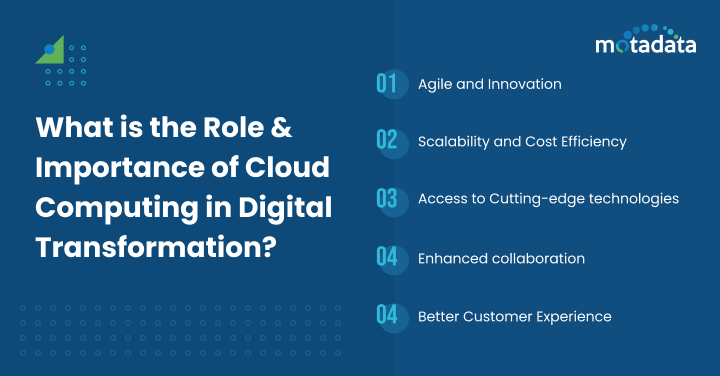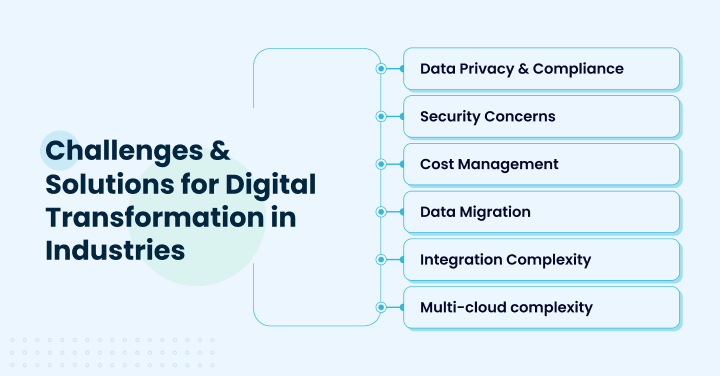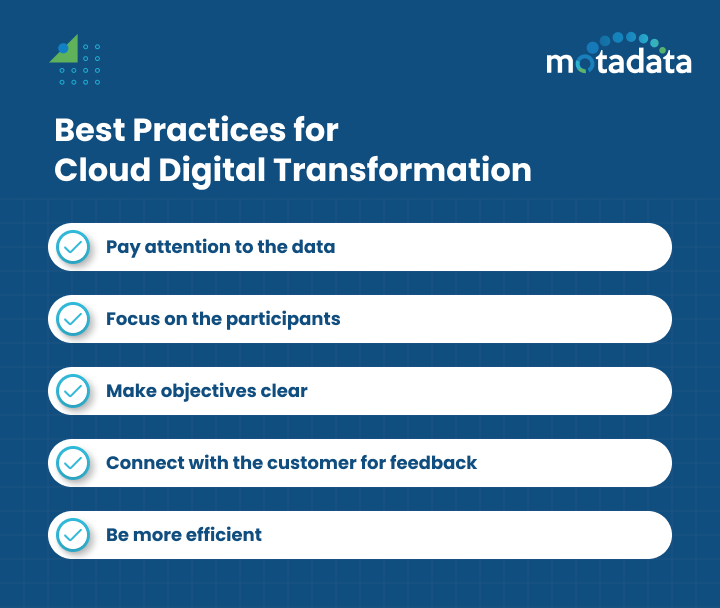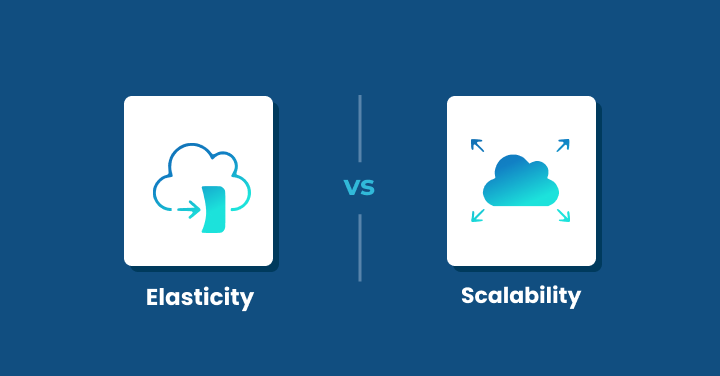Today, almost 91% of businesses are engaging with their customers in some form or the other through digital platforms.
The digital transformation that started a few years back has completely turned the tables for most industries.
Undoubtedly, the cloud’s use in digital transformation has been a game-changer. With the help of cloud computing services, businesses are able to reach a larger audience and enhance their client’s satisfaction level.
We have come a long way from launching chatbots to augmented reality and (Internet of Things) IoT devices.
In other words, cloud platforms are making the digital transformation process possible to go more quickly in the modern world.
Using this technology has other benefits besides making things easier for various departments, organizations, and industries. Earlier, managing and storing a large amount of data was difficult.
But with the adoption of cloud computing, organizations can easily store large data volumes without paying any extra amount for hardware.
Further, it is making organizations more scalable, agile, and efficient in different ways such as making more refined application software, take reference from better use cases and implement serverless computing effectively.
Let us learn more about the crucial role and importance of Cloud security in digital transformation.
Further, how it can benefit enterprises and what challenges one might face with cloud computing adoption. We will also discuss some of the best practices for Cloud Digital Transformation.
What is the Role and Importance of Cloud Computing in Digital Transformation?
Cloud computing is a major force behind digital transformation, as it provides companies with the flexibility in better disaster recovery and scale they need to innovate and multiply their application development.
It even offers storage options, servers, networking, and software that help businesses grow and deliver value to their customers.
No different types of cloud computing are appropriate for every situation, nor are all clouds created equal.
Public cloud services, private cloud, and hybrid cloud model are some essential deployment models that help deliver quick cloud computing services.
Additionally, it helps organizations save costs, expand their resources as needed, and access cutting-edge tools that accelerate digital change.
Here are a few more reasons why this practice is essential in digital transformation.
Agile and Innovation
Cloud computing allows companies to operate at lower costs, be flexible, quickly roll out new services and applications, and enhance their annual growth rate.
However, for some businesses, shifting from the cloud to on-premises infrastructure, a process known as reverse cloud migration, may offer more control over data, security, and cost management.
Digital transformation is a complex and ongoing process, so by adapting this practice and choosing the best cloud vendors, business organizations can test fresh concepts and launch new applications more quickly.
Further, it encourages creativity and boosts efficiency by supporting CI/CD pipeline integrations.
Scalability and Cost Efficiency
Another key benefit of incorporating cloud computing services in IT infrastructure is scalability. With the help of these features, businesses can add or eliminate their IT resources as per the need and growing demand.
Thus, it enables companies to save on unnecessary IT expenses in hardware and other components. Using this model, businesses will pay only for their resources, thus guaranteeing cost efficiency.
Access to Cutting-edge technologies
Artificial intelligence (AI), machine learning (ML), big data analytics, and IoT are a few advanced technologies that the service providers offer to businesses.
Using these technologies, companies can gain in-depth insights into the data collected from multiple sources, streamline operations, drive innovation, and deliver personalized experiences to their customers without significant upfront investments.
Enhanced collaboration
Another benefit of using cloud computing software is that it enhances collaboration among team members, regardless of location.
This capability has been super helpful for companies that offer SEO services and have employees working remotely from different countries. They are able to share data and collaborate on projects in real-time.
It allows team members to store and share files, thus facilitating seamless collaboration and remote work scenarios. It further helps businesses to eliminate silos, promote innovation, and achieve better results.
Better Customer Experience
By leveraging these practices, businesses can gain more visibility and insights into customer behavior and data, which can be used to improve the overall customer experience.
For example, CRM systems are used to manage customer interactions. Further, chatbots and self-service portals are a few more options that help deliver better results to end users.
How does Digital Transformation benefit enterprises?
Digital transformation powered by cloud computing provides various benefits to enterprises, such as:
1. Better Team Coordination:
Thanks to digital transformation, organizations can now operate more productively and efficiently, enhancing team coordination and collaboration.
Several cloud-based tools and platforms, such as Microsoft Teams, Slack, and Google Workspace, allow team members to connect, share confidential files securely, and work on similar projects in real-time.
Thus, it enables faster problem-solving and more informed decisions.
2. Fix the operational issues:
Cloud computing assists companies in resolving operational issues by providing scalable and reliable IT infrastructure.
Enterprises can better host their applications and manage IT resources with cloud services, thus eliminating the need for physical data centers and improving overall efficiency.
In addition, cloud-based monitoring and management solutions provide early detection and fix of such issues.
3. Discover more:
The platforms offer access to various services and tools, enabling organizations to innovate, discover new possibilities, and develop new apps.
Further, access to advanced analytics and AI tools allows organizations to analyze behavior and create new revenue streams.
4. Enhanced customer engagement:
Digital transformation has completely changed the dynamics of businesses, and by using cloud services, we can deliver personalized experiences to our customers that help enhance engagement.
Several marketing automation technologies, like customer service automation and cloud-based CRM systems, are available now that enable small businesses and government agencies to better identify and address the demands of their customers.
As a result, you may increase customer satisfaction and loyalty towards your brand.
5. Modernize the infrastructure:
By moving to the cloud infrastructure, businesses may replace their expensive and outdated physical servers with more adaptable and efficient infrastructure.
These platforms allow companies to modernize their underlying infrastructure, saving maintenance expenses, lowering costs, and increasing flexibility and scalability.
Challenges and Solutions for Digital Transformation in Industries
No doubt, digital transformation has brought various benefits of cloud computing to the industry, but at the same time, it also poses numerous challenges.
Here are some of the key challenges and solutions to overcome them, including:
1. Data Privacy and Compliance:
Ensuring data privacy and compliance is one of the significant challenges in digital transformation.
As more companies have started to rely on cloud services (Amazon Web Services, Google Cloud, IBM Cloud, Microsoft Azure), ensuring their data security and regulatory compliance has become crucial.
Many service providers have incorporated robust security measures and compliance certifications to address these concerns and safeguard customer data privacy.
Additionally, you can run regular audits or implement encryption and access controls to secure sensitive data.
2. Security Concerns:
It is highly beneficial but also raises security concerns. It makes sense that industries would be cautious about putting their private information on distant computers.
However, different cloud providers have been working on the fears and introduced encryption, firewalls, and intrusion detection systems to protect your data from unauthorized users.
So, partner with a cloud service provider who prioritizes security features and takes precautions by implementing strong authentication measures.
3. Cost Management:
Although cloud computing is inexpensive, cost management can be challenging. Companies that want to measure consumption and find ways to cut costs should put cost monitoring and optimization systems into place.
Choosing the appropriate cost models and plans following corporate requirements can also aid in efficient cost management.
4. Data Migration:
Data migration to the cloud is another challenging and time-consuming task for most IT teams. Hence, single organizations and IT professionals must carefully prepare a migration strategy.
Consider downtime, compatibility, data integrity, and other factors for a seamless transition. Collaborating with seasoned cloud migration service providers can also simplify the procedure.
5. Integration Complexity:
Integrating cloud computing with current IT systems might be difficult for some industrial sectors. The necessity of incorporating cloud-based services and apps with on-premises systems can make things complex.
Hence, several service providers provide technology services and software development tools to keep things smooth and easy.
These tools allow users to access smooth communication between cloud and on-premises systems and ensure business continuity.
6. Multi-cloud complexity:
A multi-cloud approach to stand out. However, managing a multi-cloud environment is a challenging task.
However, you can make management easier and guarantee consistency across environments using cloud management tools that offer a single view and control across several clouds.
Critical Components to Enhance Digital Transformation
Here are some of the critical components that play a crucial role in enabling successful digital transformation, including:
1. Process Mapping :
Process mapping helps identify areas for improvement by analyzing and documenting existing business processes.
It helps map out different processes so IT teams can identify bottlenecks faster and streamline workflows.
2. Data Requirement Analysis:
To fulfill their digital transformation goals, businesses must determine what data they need to gather, store, and analyze.
This involves understanding data sources, volume, variety, and velocity. The component can acquire all of these insights.
3. Choice of Technology:
Choosing the right technology is essential for successful digital transformation. Invest in a cloud service provider or platform that fits your needs and organizational goals.
Compare different service providers based on features, cost, and customer support. When selecting vendors, industries must evaluate their unique requirements, including scalability, security, data storage, and integration capabilities.
For example, if you handle massive volumes of documents, you will need a document cloud storage solution that addresses your needs.
4. Organizational Alignment:
It is imperative that the company aligns with the digital transformation goals. This entails winning over stakeholders, encouraging innovation, and providing staff members with assistance and training.
Organizational alignment can be ensured through effective communication and change management techniques.
Best Practices for Cloud Digital Transformation
Every industry must incorporate a few best practices for a successful cloud digital transformation.
1. Pay Attention To The Data
Data is crucial for any business, especially in the case of digital transformation. Cloud adoption unlocked various challenges, but at the same time, things got easier.
But to keep data safe and secure, you should pay meticulous attention to your data. Implement effective data management practices to guarantee better security, quality, and integrity. In many cases, automated data processing supports these practices by minimizing manual errors, improving accuracy, and ensuring consistency across systems.
Organizations must create policies for data governance, put data security measures in place, and evaluate data quality regularly.
2. Focus on the Participants
Staff members are essential to the digital transformation process. Companies should work to empower and engage staff members or employees by giving them the right tools and training.
Fostering an innovative and collaborative culture may fuel successful transformation projects.
3. Make objectives clear
Digital transformation requires objective goals that are both measurable and clear. Businesses should clearly define key performance indicators (KPIs) and goals to monitor development and assess success. Having a well-defined strategy guarantees that transformation initiatives remain on course.
4. Connect with the customer for feedback
The ability to interact with consumers and get their feedback is a crucial component of the technological advancements made possible by cloud computing.
Customer input is extremely valuable for businesses trying to enhance their offerings and provide a better user experience.
It gives companies the infrastructure and resources to instantly gather, evaluate, and respond to consumer feedback.
Businesses can better understand their consumers’ requirements, interests, and behaviors using cloud-based customer relationship management (CRM) systems.
They can serve their customers better and personalize their services, increasing consumer happiness and loyalty.
5. Be more efficient
is flexible and scalable, it enables businesses to streamline their operations and eliminate inefficiencies, which lowers costs and boosts productivity.
Further, using tools for automation and optimization on the cloud can assist in increasing efficiency.
FAQs:
Cloud computing provides agility and flexibility for businesses to adapt to changing market environments.
It allows organizations to quickly scale their IT resources based on needs and market demand.
Access to cutting-edge technologies and the opportunity for experimentation and cooperation are two ways cloud computing promotes innovation.
In the current digital era, organizations must embrace digital transformation. It gives businesses a competitive edge by allowing them to deliver innovative products and solutions, disrupt industries by eliminating the need for costly maintenance and upgrades, and adjust to changing market trends.
Businesses that want to remain relevant and competitive in the ever-changing digital market must embrace digital transformation.
There are several financial benefits to using cloud computing for digital transformation. Firstly, it prevents companies from investing in expensive IT infrastructure.
Secondly, it increases operational efficiency by automating manual tasks and streamlining processes.
This eventually reduces human error rates and increases productivity. Lastly, cloud computing offers a cost-effective way for companies to drive digital transformation and meet their strategic objectives.
It enhances collaboration and remote work by providing appropriate tools for smooth file sharing, real-time communication, and better project management. As a result, remote collaboration will increase your employees’ productivity and flexibility.









